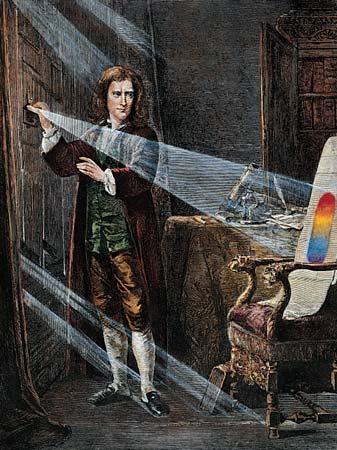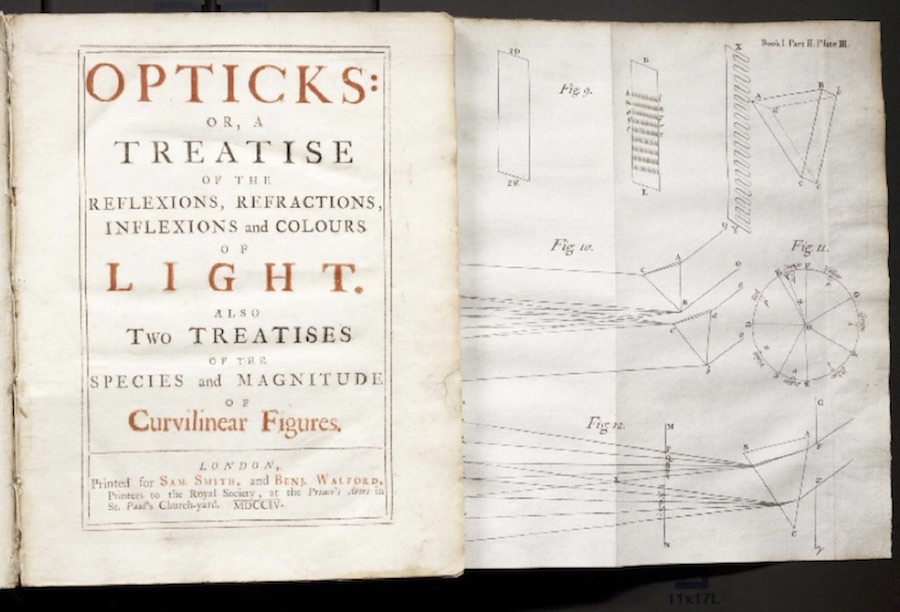Why Do Physics and Art Have Different Primary Colors
- Habitation
- The Science of Color
- Making Colour
- Matching Color
- Using colour
- Events and Info
The Scientific discipline of Color
 |
| Sir Isaac Newton experimenting with a prism. Engraving after a flick by J.A. Houston, ca. 1870. Courtesy of The Granger Collection, New York |
In the 1660s, English language physicist and mathematician Isaac Newton began a series of experiments with sunlight and prisms. He demonstrated that clear white lite was composed of seven visible colors.
Past scientifically establishing our visible spectrum (the colors we see in a rainbow), Newton laid the path for others to experiment with color in a scientific way. His work led to breakthroughs in optics, physics, chemical science, perception, and the written report of color in nature.
Aristotle developed the commencement known theory of color believing it was sent past God from heaven through celestial rays of light. He suggested that all colors came from white and black (lightness and darkness) and related them to the 4 elements – water, air, earth, and burn down. Aristotle's beliefs on colour were widely held for over 2000 years until being replaced by those of Newton.
 |
| Sir Isaac Newton |
Opticks, one of the great works in the history of scientific discipline, documents Newton's discoveries from his experiments passing lite through a prism. He identified the ROYGBIV colors (red, orange, yellow, green, bluish, indigo, and violet) that make up the visible spectrum. The visible spectrum is the narrow portion inside the electromagnetic spectrum that can be seen past the man eye. Other forms of electromagnetic radiations, waves of free energy, that we cannot see include radio, gamma and microwaves. The cells in our eyes called cones are sensitive to the wavelengths found in the visible spectrum. They let united states of america to see the all the colors of the rainbow.
…if the Sun's Light consisted of but one sort of Rays, there would be but one Colour in the whole World…
–Sir Isaac Newton, Opticks
![Johann Wolfgang von Goethe. Zur Farbenlehre [Theory of Colors]. Tübingen: J.G. Cotta'schen Buchhandlung, 1810](https://library.si.edu/sites/default/files/styles/panopoly_image_quarter/public/39088007009129_0031_0.jpg?itok=lOj3rKOm) | ![Johann Wolfgang von Goethe. Zur Farbenlehre [Theory of Colors]. Tübingen: J.G. Cotta'schen Buchhandlung, 1810](https://library.si.edu/sites/default/files/styles/panopoly_image_quarter/public/39088007009129-0039.jpg?itok=CEBtQfCs) | ![Johann Wolfgang von Goethe. Zur Farbenlehre [Theory of Colors]. Tübingen: J.G. Cotta'schen Buchhandlung, 1810](https://library.si.edu/sites/default/files/39088007009129-0035.jpg) |
| Johann Wolfgang von Goethe | ||
Goethe challenged Newton's views on colour, arguing that color was non simply a scientific measurement, but a subjective experience perceived differently by each viewer. His contribution was the beginning systematic study on the physiological effects of color. Goethe's views were widely adopted by artists. Although Goethe is best known for his poetry and prose, he considered Theory of Colors his nigh of import work.
Colour are low-cal's suffering and joy.
–Johann Wolfgang von Goethe
This very rare book formed the foundation for modern color printing. Le Blon was the first to outline a 3-color press method using primary colors (carmine, yellowish, bluish) to create secondary colors (green, purple, orange). He makes an important distinction between "cloth colors," as used by painters, and colored light, which was the focus of Newton's color theories. Le Blon'southward stardom marks the first documentation of what is now referred to every bit additive and subtractive color systems. Rainbows, TVs, figurer screens and mobile devices all emit light and are examples of an additive colour arrangement (the subject of Newton's Opticks). Red, light-green and blueish are the master additive colors and when combined they produce transparent white light. Books, paintings, grass and cars are examples of a subtractive colour system which is based on the chemical makeup of an object and its reflection of lite as a color. Subtractive primary colors - blue, red, and yellow – are often taught to us as children, and when mixed together they create blackness.
…I arriv'd at the skill of reducing the Harmony of Colouring in painting to Mechanical Practice…
–J.C. Le Blon, Coloritto
These colorful line diagrams reveal the chemical compositions of metals. When a pure metal is burned and viewed through a spectroscope, each element gives off unique spectra, a sort of colour fingerprint. This method, called spectral analysis, led to the discovery of new elements, and marked the first steps towards quantum theory.
Tin yous see the numbers in the circles? 4.v per centum of the population cannot run into the entire visible spectrum, a condition chosen colour vision deficiency, or color blindness. Ishihara plates are used to test patients for the various types of color blindness.
Tin can you find the brute hiding in this image? Cover-up uses color to conceal forms past creating optical illusions. American artist Abbott Thayer introduced the concept ofconfusing patterning, in which an animal's uneven markings tin can disguise its outline. In this analogy Thayer shows how a peacock can disappear into its environment.
Thayer, an American artist, devoted much of his life to understanding how animals conceal themselves in nature for survival. In his book, Concealing Coloration in the Animal Kingdom, Thayer presented his beliefs of protective coloration as an essential factor in development helping animals disguise themselves from predators. He received much praise and criticism. He was extreme in his views arguing that all animal coloration was for protective purposes and failing to recognize other possible reasons such as sexual selection – characteristics for attracting a mate. Teddy Roosevelt virtually notably attacked his theories past pointing out that this darkening doesn't last all season, or even all 24-hour interval, but was dependent on a unmarried frozen moment in times. Despite these shortcomings, Thayer went on to exist the first to propose cover-up for military purposes. Although his suggestions were initially rejected, his former students were among the founders of the American Camouflage Social club in 1916 and his theories were eventually adopted and are still used today.
 |
| Albatross D.Va, 1917-1918 Courtesy of the National Air and Infinite Museum |
The colorful pattern on this German language aircraft from Globe War I is called lozenge camouflage. Its disruptive blueprint applied Abbott Thayer'southward theories in an effort to inhibit enemy observation from the air and on the ground.
Source: https://library.si.edu/exhibition/color-in-a-new-light/science
0 Response to "Why Do Physics and Art Have Different Primary Colors"
Postar um comentário